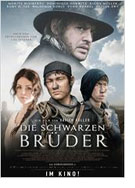

Opening 17 Apr 2014
Directed by:
Xavier Koller
Writing credits:
Fritjof Hohagen, Klaus Richter, Lisa Tetzner, Kurt Held
Principal actors:
Fynn Henkel, Moritz Bleibtreu, Waldemar Kobus, Richy Müller, Oliver Ewy
This children’s film is based on a book written by Lisa Tetzner in 1941. The idea was conceived from a true event which Tetzner read in the newspaper. Somewhere along the border of Switzerland and Italy a ferry disaster occurred and some thirty boys drowned before they made it to their final destination: the city of Milan. Some might say they were lucky since they had been sold into child labor work. They were to work as chimney sweeps, which was quite common in the mid-19th century due to poverty. Tetzner paints a grim picture since the children were forced to climb through pitch black chimneys and were facing an early death due to lung disease and malnutrition. When they did receive their earnings, it was often confiscated from them or stolen by the other street gangs, leaving these kids with little hope.
There have been many adaptations of this book, ranging from radio to television and even including a Japanese version. In this adaptation director Xavier Koller focuses on Giorgio’s (Fynn Henkel) character. We see how close he is to his family and, due to a serious accident where his mother will die if they don’t come up with the money to pay the doctor, he is forced to take on this job as chimney sweep. Antonio Luini (Moritz Bleibtreu) comes collecting the boys from the mountain villages, and then the ferry accident occurs, but he continues on with the few boys that survive. In Milan Giorgio and his friend quickly build up a gang, and even confront the other gangs, where they soon become a united group. It could be the seed of a future union for the workers but definitely reveals the hardships that children had to face in the past in Europe and are still faced with in other Third World countries.
It is a very good educational tool for children to watch and discuss. The film is in German and, while showing hard moments, it also includes humor, which makes it easier for children to watch and think about the story. (Shelly Schoeneshoefer)